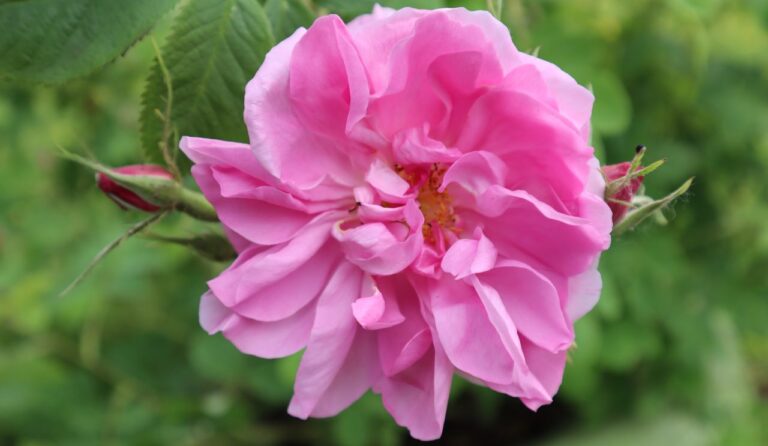Lavender has long been celebrated for its beauty, fragrance, and versatility. In a recent visit to Exemplar Horticulture, Jason from Fraser Valley Rose Farm sat down with Julia, an expert grower, to explore the many varieties of lavender and help gardeners determine which type might best suit their needs. Exemplar Horticulture grows 24 different varieties, but as Julia explains, they fall into three main groups: English, Lavandin, and Spanish lavender.
This article dives into the unique qualities of each group, highlighting their characteristics, growing conditions, and ideal uses in the garden.
English Lavender: The Classic Choice
English lavender (Lavandula angustifolia) is perhaps the most well-known and widely grown type of lavender. Renowned for its sweet, aromatic fragrance and versatility, this variety is a staple in both gardens and kitchens.
- Characteristics:
English lavender produces dense, compact flower spikes in shades of purple and blue. Its height generally ranges from 2 to 3 feet, making it a manageable choice for garden beds or borders. - Bloom Time:
These varieties bloom earlier in the summer, typically from late June to July, adding a beautiful splash of color during the season. - Cold Hardiness:
Hardy to USDA Zone 5, English lavender is well-suited for cooler climates. - Popular Varieties:
Munstead and Hidcote are classic choices, while newer varieties like Sweet Romance and Annette offer enhanced vigor and color.
Jason noted that English lavender is ideal for perfumery and culinary uses, thanks to its bold flavor and scent. It’s a perfect choice for gardeners who prioritize fragrance and versatility.
Lavandin: Bigger, Bolder, and Later Blooming
Lavandin (Lavandula × intermedia) is a hybrid between English lavender and Portuguese lavender. As Julia described, lavandin is like an “amped-up” version of English lavender, offering a more vigorous growth habit and stronger fragrance.
- Characteristics:
Lavandin varieties have taller flower spikes and a stretchier habit compared to English lavender. They also produce a more potent, camphor-like fragrance. - Bloom Time:
These varieties bloom later in the summer, making them a great companion to English lavender for a prolonged lavender display in the garden. - Cold Hardiness and Heat Tolerance:
Like English lavender, lavandin is hardy to Zone 5 but offers slightly better tolerance to heat. - Popular Varieties:
Provençal and Grosso are standout examples, offering bold flowers and exceptional fragrance.
Julia suggested planting English and lavandin varieties together to enjoy sequential blooms and create dynamic layers in the garden.
Spanish Lavender: Bold Flowers and Heat Tolerance
Spanish lavender (Lavandula stoechas) stands out for its unique flower shape and ability to thrive in warmer climates. Unlike the other types, its appeal lies more in its ornamental qualities than in its fragrance.
- Characteristics:
Spanish lavender produces bold flowers with colorful “flags” on top, creating a striking visual display. Its fragrance, while present, is less refined than that of English or lavandin varieties. - Bloom Time:
This lavender blooms earlier in the season, making it a great choice for adding early color to the garden. - Heat Tolerance:
Spanish lavender excels in hot climates, where other types may struggle. - Popular Varieties:
Silver Anouk, with its silvery foliage and vibrant flowers, is a standout example.
Jason also highlighted some lesser-known lavender types with excellent heat tolerance, including hybrid lavenders like Lavandula × chaytorae and species like French and Egyptian lavender. These options provide even more flexibility for gardeners in warm climates.
How to Choose the Right Lavender for Your Garden
When selecting lavender, consider the following factors:
- Climate:
English and lavandin varieties thrive in temperate climates, while Spanish lavender and hybrid types are better suited for hot, dry conditions. - Purpose:
If fragrance is your priority, English and lavandin varieties are the best options. For bold, ornamental flowers, Spanish lavender is the way to go. - Bloom Time:
Mix and match varieties to create a continuous bloom cycle throughout the summer. - Height and Habit:
English lavender offers a compact growth habit, while lavandin provides taller, more vigorous plants for larger spaces.
Conclusion: A Lavender for Every Garden
Lavender offers something for everyone, whether you’re seeking the refined fragrance of English lavender, the robust beauty of lavandin, or the bold ornamental appeal of Spanish varieties. As Jason and Julia demonstrated, understanding the characteristics of each type allows gardeners to make informed decisions that suit their unique needs and preferences.







